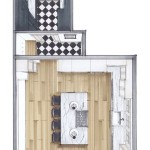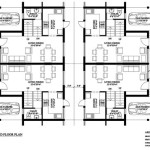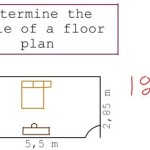Simple 2D Floor Plan with Dimensions: A Comprehensive Guide
The creation of a 2D floor plan is a fundamental step in architectural design, interior design, and even real estate planning. A 2D floor plan is a bird's-eye view of a space, depicting walls, doors, windows, and other essential features on a single, flat plane. The addition of accurate dimensions elevates a simple plan from a basic sketch to a precise and usable document for construction, renovation, or space planning. This article will explore the key elements of a simple 2D floor plan, emphasizing the importance of dimensions and providing a clear understanding of how such plans are utilized across various industries.
A 2D floor plan, unlike its 3D counterpart, provides a simplified and straightforward representation of the spatial layout. The plan's primary purpose is to communicate the relationships between different rooms, the overall size of the building or space, and the location of key features. The accuracy and clarity of a 2D floor plan significantly impact its usefulness. A well-executed plan minimizes ambiguities and ensures that all stakeholders, from contractors to homeowners, have a shared understanding of the design.
Dimensions are critical for transforming a basic floor plan into a valuable tool. Without dimensions, the floor plan serves only as a rudimentary overview. Dimensions provide the exact measurements of walls, rooms, door openings, window sizes, and other important elements. These measurements are essential for accurate material estimation, furniture placement planning, and ensuring that the final construction matches the intended design. Careful consideration must be given to the units of measurement used (e.g., feet, inches, meters, centimeters) and ensuring consistency throughout the plan.
There are several software options available for creating 2D floor plans, ranging from simple drawing tools to sophisticated CAD (Computer-Aided Design) programs. Simpler software might be suitable for basic layouts, while CAD programs offer greater precision and functionality for complex projects. In either case, understanding the principles of creating accurate and dimensioned plans is essential. Furthermore, clear dimensioning practices are crucial, involving consistent line placement, readable font sizes, and clear indication of what each dimension represents.
Key Point 1: Essential Elements of a 2D Floor Plan
A standard 2D floor plan incorporates several key elements that contribute to its clarity and usability. Walls are the fundamental components, defining the boundaries of rooms and the overall shape of the building. Walls are typically represented by solid lines of varying thickness, often with different line types to distinguish between exterior and interior walls. Doors are indicated by a curved line that shows the direction of the door swing and its position within the wall opening. Windows are shown as gaps in the walls, typically with additional lines indicating the window frame and sash. Stairs, if present, are represented by a series of parallel lines indicating the steps, along with an arrow indicating the direction of ascent or descent. Fixtures, such as sinks, toilets, bathtubs, and appliances, are also included to provide a more complete picture of the space. Each of these elements must be drawn accurately and proportionally to reflect their actual size and position within the overall floor plan. In addition, clear labeling of rooms and other features is crucial for easy understanding. For example, labeling "Bedroom," "Kitchen," or "Bathroom" clarifies the function of each area.
Dimensions are an inseparable element of a floor plan's usefulness. The inclusion of dimensions provides definitive measurements, enabling construction and design processes to proceed efficiently and accurately. Linear dimensions, denoting the length of walls and distances between elements, are crucial. Room dimensions, showing the internal length and width of each room, are also essential. Door and window dimensions indicate the size of the openings, facilitating the selection of appropriate doors and windows. The overall building dimensions, representing the total length and width of the structure, provide a comprehensive scale for the project. All dimensions should be clearly indicated using dimension lines, extension lines, and numerical values with appropriate units. Proper placement of dimension lines is key; they should be located outside the walls to avoid cluttering the interior space. Furthermore, dimension values should be legible and consistent in terms of font size and style.
Key Point 2: The Importance of Accurate Dimensioning
Accurate dimensioning is paramount in a 2D floor plan. Inaccurate dimensions can lead to significant errors in construction, resulting in costly rework, material waste, and overall project delays. When dimensions are imprecise, contractors may miscalculate material quantities, resulting in shortages or surpluses. Incorrect room dimensions can lead to furniture not fitting properly, impacting the functionality and aesthetics of the space. Moreover, inaccurate door and window dimensions can lead to ordering the wrong sizes, further delaying the project and adding to expenses.
Several factors contribute to accurate dimensioning. First, using precise measuring tools is critical. Laser distance measurers provide accurate readings, minimizing the risk of human error. Second, consistent application of dimensioning standards is essential. Following established architectural conventions ensures clarity and avoids ambiguity. Third, double-checking all dimensions is crucial. Verifying measurements reduces the likelihood of mistakes and ensures the overall accuracy of the floor plan. Fourth, choosing appropriate dimensioning units (e.g., feet and inches, meters and centimeters) and consistently using them across the entire plan is critical. A mix of units can lead to confusion and errors. Finally, clear and legible dimension text is essential. The font size should be large enough to be easily read, and the placement of the text should be clear and unambiguous.
The benefits of accurate dimensioning extend beyond avoiding construction errors. Accurate floor plans facilitate better communication among all stakeholders involved in the project. Architects, contractors, interior designers, and homeowners can all refer to the same plan and have a shared understanding of the design. This reduces the risk of misunderstandings and ensures that the project proceeds smoothly. Accurate dimensions also enable more efficient material procurement. Contractors can order the precise amount of materials needed, minimizing waste and reducing costs. Furthermore, accurate floor plans are valuable for space planning. Homeowners can use the dimensions to plan furniture placement and ensure that their belongings will fit comfortably in the space.
Key Point 3: Utilizing 2D Floor Plans with Dimensions
2D floor plans with dimensions are utilized across a wide range of industries and applications. In architectural design, they are the foundation for creating detailed building plans. Architects use 2D floor plans to visualize the layout of a building, determine room sizes, and plan the placement of doors, windows, and other features. The dimensions provide the necessary information for creating more detailed drawings, such as elevations and sections. In construction, contractors rely on 2D floor plans with dimensions for building the structure according to the design specifications. The dimensions guide the placement of walls, the installation of doors and windows, and the overall construction of the building. Accurate dimensions ensure that the building is constructed to the correct size and shape.
Interior designers use 2D floor plans with dimensions for space planning and furniture layout. The dimensions help them determine the size and placement of furniture, ensuring that the space is functional and aesthetically pleasing. Designers can use the floor plan to create different furniture layouts and visualize how the space will look with different arrangements. Real estate agents utilize 2D floor plans with dimensions for marketing properties to potential buyers or renters. The floor plan provides a clear overview of the property's layout and helps potential buyers or renters visualize the space and determine if it meets their needs. The dimensions provide additional information about the size of rooms and the overall size of the property.
Beyond these core industries, 2D floor plans with dimensions also find applications in facility management, where they are used for managing and maintaining buildings. The floor plans provide a detailed record of the building's layout, including the location of utilities, equipment, and other assets. This information is valuable for planning maintenance and repairs. In disaster response, floor plans can be used by emergency responders to navigate buildings and locate occupants. The dimensions provide information about the size and layout of the building, which can be critical in emergency situations. Furthermore, the creation and storage of dimensioned 2D floor plans is an essential component of Building Information Modeling (BIM) workflows, serving as important data points for the development of more complex and detailed 3D models.

2d Floor Plans Plan Design Home Small Kitchen

Draw 2d Floor Plans In Minutes Not Hours Cedreo

Beautiful 2d Floor Plan Ideas Engineering Discoveries Square House Plans Bungalow Simple

Create Professional 2d Floor Plans Roomsketcher

12 Examples Of Floor Plans With Dimensions

Residence Project Detail Specified In This Autocad Drawing File 2d Auto Cad Simple Floor Plans

Create Professional 2d Floor Plans Roomsketcher

2d Floor Plan Commercial Real Estate It All

2d Floor Plan Archives Page 2 Of 6 Dk Home Designx

2d Drawing Gallery Floor Plans House
Related Posts








